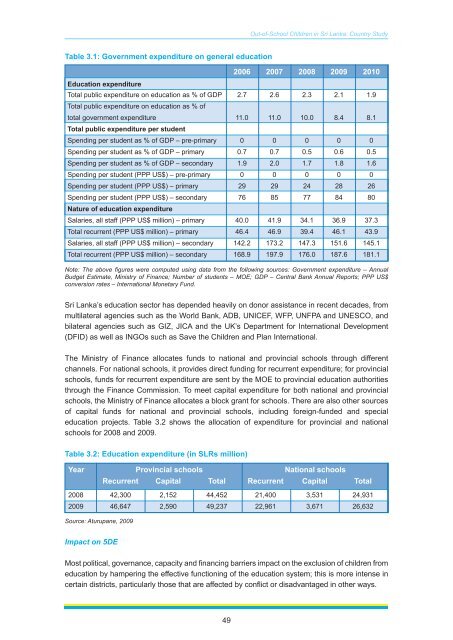Sri Lanka - Institut de statistique de l'Unesco
Sri Lanka - Institut de statistique de l'Unesco
Sri Lanka - Institut de statistique de l'Unesco
Create successful ePaper yourself
Turn your PDF publications into a flip-book with our unique Google optimized e-Paper software.
Out-of-School Children in <strong>Sri</strong> <strong>Lanka</strong>: Country Study<br />
Table 3.1: Government expenditure on general education<br />
2006 2007 2008 2009 2010<br />
Education expenditure<br />
Total public expenditure on education as % of GDP 2.7 2.6 2.3 2.1 1.9<br />
Total public expenditure on education as % of<br />
total government expenditure 11.0 11.0 10.0 8.4 8.1<br />
Total public expenditure per stu<strong>de</strong>nt<br />
Spending per stu<strong>de</strong>nt as % of GDP – pre-primary 0 0 0 0 0<br />
Spending per stu<strong>de</strong>nt as % of GDP – primary 0.7 0.7 0.5 0.6 0.5<br />
Spending per stu<strong>de</strong>nt as % of GDP – secondary 1.9 2.0 1.7 1.8 1.6<br />
Spending per stu<strong>de</strong>nt (PPP US$) – pre-primary 0 0 0 0 0<br />
Spending per stu<strong>de</strong>nt (PPP US$) – primary 29 29 24 28 26<br />
Spending per stu<strong>de</strong>nt (PPP US$) – secondary 76 85 77 84 80<br />
Nature of education expenditure<br />
Salaries, all staff (PPP US$ million) – primary 40.0 41.9 34.1 36.9 37.3<br />
Total recurrent (PPP US$ million) – primary 46.4 46.9 39.4 46.1 43.9<br />
Salaries, all staff (PPP US$ million) – secondary 142.2 173.2 147.3 151.6 145.1<br />
Total recurrent (PPP US$ million) – secondary 168.9 197.9 176.0 187.6 181.1<br />
Note: The above figures were computed using data from the following sources: Government expenditure – Annual<br />
Budget Estimate, Ministry of Finance; Number of stu<strong>de</strong>nts – MOE; GDP – Central Bank Annual Reports; PPP US$<br />
conversion rates – International Monetary Fund.<br />
<strong>Sri</strong> <strong>Lanka</strong>’s education sector has <strong>de</strong>pen<strong>de</strong>d heavily on donor assistance in recent <strong>de</strong>ca<strong>de</strong>s, from<br />
multilateral agencies such as the World Bank, ADB, UNICEF, WFP, UNFPA and UNESCO, and<br />
bilateral agencies such as GIZ, JICA and the UK’s Department for International Development<br />
(DFID) as well as INGOs such as Save the Children and Plan International.<br />
The Ministry of Finance allocates funds to national and provincial schools through different<br />
channels. For national schools, it provi<strong>de</strong>s direct funding for recurrent expenditure; for provincial<br />
schools, funds for recurrent expenditure are sent by the MOE to provincial education authorities<br />
through the Finance Commission. To meet capital expenditure for both national and provincial<br />
schools, the Ministry of Finance allocates a block grant for schools. There are also other sources<br />
of capital funds for national and provincial schools, including foreign-fun<strong>de</strong>d and special<br />
education projects. Table 3.2 shows the allocation of expenditure for provincial and national<br />
schools for 2008 and 2009.<br />
Table 3.2: Education expenditure (in SLRs million)<br />
Year Provincial schools National schools<br />
Recurrent Capital Total Recurrent Capital Total<br />
2008 42,300 2,152 44,452 21,400 3,531 24,931<br />
2009 46,647 2,590 49,237 22,961 3,671 26,632<br />
Source: Aturupane, 2009<br />
Impact on 5DE<br />
Most political, governance, capacity and financing barriers impact on the exclusion of children from<br />
education by hampering the effective functioning of the education system; this is more intense in<br />
certain districts, particularly those that are affected by conflict or disadvantaged in other ways.<br />
49

















